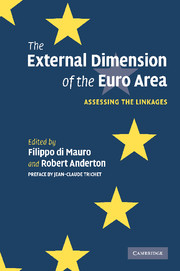Book contents
- Frontmatter
- Contents
- List of illustrations
- List of contributors
- Preface by Jean-Claude Trichet
- 1 Introduction
- 2 The external dimension of the euro area: stylised facts and initial findings
- 3 Product variety and macro trade models: implications for the new EU Member States
- 4 Exchange-rate pass-through to import prices in the euro area
- 5 The international equity holdings of euro area investors
- 6 Global linkages through foreign direct investment
- 7 Shocks and shock absorbers: the international propagation of equity market shocks and the design of appropriate policy responses
- 8 The euro area in the global economy: its sensitivity to the international environment and its influence on global economic developments
- Index
- References
5 - The international equity holdings of euro area investors
Published online by Cambridge University Press: 22 September 2009
- Frontmatter
- Contents
- List of illustrations
- List of contributors
- Preface by Jean-Claude Trichet
- 1 Introduction
- 2 The external dimension of the euro area: stylised facts and initial findings
- 3 Product variety and macro trade models: implications for the new EU Member States
- 4 Exchange-rate pass-through to import prices in the euro area
- 5 The international equity holdings of euro area investors
- 6 Global linkages through foreign direct investment
- 7 Shocks and shock absorbers: the international propagation of equity market shocks and the design of appropriate policy responses
- 8 The euro area in the global economy: its sensitivity to the international environment and its influence on global economic developments
- Index
- References
Summary
Introduction
The integration of euro area financial markets since the launch of the euro in 1999 has been at the centre of attention in policy debate and academic literature. This chapter complements this much-explored line of research by examining a subject that has attracted much less attention – namely, the characteristics of the euro area's external portfolio investment, and particularly the geographical allocation of the international equity portfolios held by euro area investors.
The geography of the euro area's external equity holdings is important for several reasons. First, the level of holdings in each international market is a direct determinant of the euro area's exposure to external financial shocks. Second, it is also useful to assess whether international investment provides diversification against internal risks. Third, differences in the composition of international portfolios between the euro area and other major economic blocs (e.g. the United States and Japan) may generate asymmetric responses to international financial crises or global shocks, which in turn may pose a challenge for coordinated management of the international financial system.
Our empirical work is made possible by the release of the International Monetary Fund's Coordinated Portfolio Investment Survey (CPIS). This dataset, described more in detail in section 5.2, provides a unique perspective on the geographical patterns of international portfolio holdings for most major international investors, including the entire euro area.
- Type
- Chapter
- Information
- The External Dimension of the Euro AreaAssessing the Linkages, pp. 95 - 117Publisher: Cambridge University PressPrint publication year: 2007
References
- 5
- Cited by



